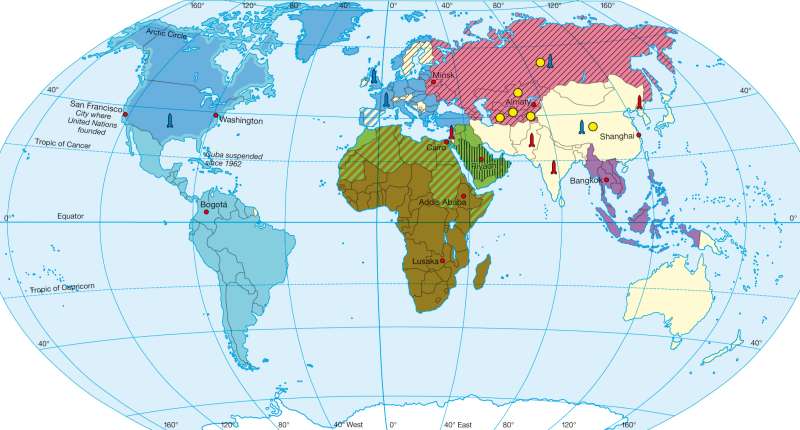Political and military alliances 2010
The world - Alliances since World War Two
978-3-14-100790-9 | Page 187 | Ill. 3

Information
NATO has been the most important military alliance in the world since the collapse of the bi-polar alliance structures of the Cold War. The collaboration within the "Partnership for Peace"- includes non-aligned countries such as Sweden, Finland, Switzerland, Austria and Ireland. In Eastern Europe, Russia has largely lost its military influence. Many states such as Poland, Czech Republic, Hungary and the Baltic republics have now joined NATO. The only Muslim member of NATO is Turkey. France and Spain are independent military members. Iceland does not have its own armed forces. NATO's headquarters are in Brussels, Belgium, but it was first established in Washington.In the Americas, the OAS serves as an alliance for the joint military security. Cuba and some overseas territories such as French Guyana are non-members which have only been suspended since 1962. In addition to the common external security, there is also the intergovernmental conflict resolution role of the OAS in the Americas. Its seat is in Washington, but was established in Bogotá.
With the exception of the Baltic republics, the CIS is identical to the former Soviet Union. It was supposedly not intended as a military alliance, but instead should have served the political, economic and cultural co-operation between certain countries such as Belarus and Russia. Also, a high degree of integration in the defence area was regulated by a contract. Given that the CIS could not meet the expectations placed on it, from 1996, a series of regional alliances including the GIS (Russia, Belarus, Kazakhstan and Kyrgyzstan), the GSR (Russia and Belarus), the GUUAM (Georgia, Ukraine, Azerbaijan, Moldova and Uzbekistan) and the CACO (Kazakhstan, Kyrgyzstan, Tajikistan and Uzbekistan) were contained in their scope. In 1999, Azerbaijan, Georgia and Uzbekistan withdrew from the CIS. Founded in Minsk, it has no fixed seat.
Aside from the Islamic countries of West Asia, The Arab League includes north and east African countries, including the Comoros, Iran, Pakistan, Afghanistan and the Central Asian states. Turkey is excluded from The Arab League. It serves the broad promotion of co-operation among countries in the political, economic, cultural and social fields, as well as arbitration of disputes between states and represents common Arab interests abroad. A central aim is the establishment of a Palestinian state. The Arab League also includes arrangements for defence, but is not a military alliance such as the CIS. Its headquarters are in Cairo, Egypt.
The adjacent gulf states of Bahrain, Qatar, Kuwait, Oman, Saudi Arabia and the United Arab Emirates formed the Gulf Cooperation Council within the Arab region, which is a regional, peacekeeping and defence-oriented military alliance and was established in Riyadh.
With the exception of Morocco, the Islamic countries of North Africa, like all other countries of the continent, are members of the African Union, a succession organisation founded in 1963. In 2002, the Organisation of African Unity (OAU) was dissolved. The African Union is not a military alliance, but is rather an intra-African co-operation and serves external common interests. Its headquarters are in Addis Ababa, Ethiopia.
In Southeast Asia, Brunei, Cambodia, Indonesia, Laos, Malaysia, Myanmar, Philippines, Singapore, Thailand and Vietnam established a mainly economic, cultural and socially-oriented regional alliance with ASEAN, which aims for a similar level of integration as the EU. Not least because of this alliance, some of the participating countries developed so-called tiger economies in recent years with strong economic momentum. However, peacekeeping is one of the stated objectives; the ASEAN states, like the Arab League and the CIS, seemingly not having a military alliance. Its seat is in Jakarta, Indonesia.
Other regional organisations which are not shown here include the Arctic Council, the APEC (economic alliance in the Asia-Pacific) the Non-Aligned Nations, the Commonwealth of Nations, the EU, the group of nine (G9), NAFTA and as an economic alliance-MERCOSUR. Others are also the Maghreb Union (Algeria, Libya, Morocco, and Mauritania), the Organisation of Islamic Conference and the OSCE. Regarding the represented pacts/treaties, there are numerous examples of co-operation of the individual states.
M. Felsch; Ü: C. Fleming




